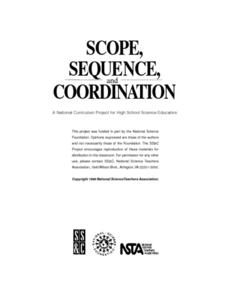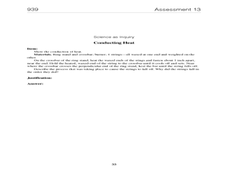Curated OER
Variations in Living Things
Biology beginners observe traits in a collection of plant parts to realize the tremendous amount of genetic variation within a species. They consider rules of nature and discuss what would happen if they changed. They also examine data...
Curated OER
Structures That Reveal Common Ancestry
Float like a butterfly, sting like a bee, check out wing shapes for common ancestry! Beginning biologists compare wings as analogous structures and discover that environment influences evolution of adaptations. A third activity relies on...
Curated OER
Cells: A First-Hand View
In the first of two activities, your charges prepare wet mount slides of cork and bean sprout cells in imitation of Robert Hooke's historical investigation. An excerpt from his notes is included. Then, investigators compare animal cells...
Curated OER
Evidence of Heat Transformations
Earth, life, and physical science classes can all benefit from understanding heat transfer. There is not room enough to describe these seven exceptional laboratory experiments that explore conduction, convetcion, and radiation. Several...
Curated OER
Relative Positions of the Earth, Moon, and Sun Over Time
Teacher pages for four different activities and three assessments are provided in this resource. Topics deal with how the sun's position and Earth's atmosphere affect the amount of solar energy reaching Earth's surface. The concepts and...
Curated OER
Prokaryotes and Eukaryotes
Examine cyanobacteria cells as an example of prokaryotes and several other alga as examples of eukaryotes. Future biologists compare the two and notice the absence of nuclei in prokaryotes. These are classic activities for this purpose,...
Curated OER
A Wall for Peace?
Students give examples that demonstrate how people are connected to each other and the environment. They idnetify current or historic conflicts and explain how those conflicts are or were influenced by geography. Students explore about...
University of Minnesota
Connect the Neurons!
Create a neuron frenzy as your pupils play the part of the neurons. An engaging lesson creates a human chain of neurons that pass cotton balls posing as neurotransmitters. Scholars learn about pre- and post-synapses as they complete...
Curated OER
How to Become a Member of Congress
Young scholars identify requirements for becoming a U.S. Representative or a U.S. Senator, explain procedure for running for representative or senator, and create an informational brochure.
University of Minnesota
Sheep Brain Dissection
Bored with frog and earthworm dissections? Had your fill of fetal pigs? Anatomy students will be intrigued by the sheep's brain, and you will be prepared with guiding questions, extension activities, and pictures as they dissect one —...
Curated OER
Initial Fraction Ideas Lesson 5: Overview
Students demonstrate fraction symbols. In this fractions lesson plan, students use paper strips to represent various fractions. Students then use fraction circles to compare various given fractions.
Curated OER
Initial Fraction Ideas Lesson 19: Overview
Students read different scenarios and discuss how to add fractions. in this addition of fractions lesson plan, students learn how to add unlike fractions and practice 4 problems.
Curated OER
Example of Convection
Compare the density of different salt solutions and then observe currents that are caused by the difference. Set up a demonstration of dynamic equilibrium. The intent with these activities is to begin building understanding of density...
Curated OER
Construction of Food Chains and Tracing Energy Changes
If you need a few basic activities for teaching food chains to your emerging ecologists, here they are. Three sheets of organism cards are included for learners to cut out and arrange according to trophic relationships. To make the most...
Curated OER
Trophic Pyramids and Levels
The bulk of this lesson plan involves the construction of both an aquatic and a terrestrial ecosystem in which to observe trophic relationships. Detailed directions are provided, as well as discussion questions, and assessment...
Curated OER
Populations
Take your ecology aces out in the field to practice population counts and model the benefits of camouflage. Though not particularly exciting, these activites and the assessments that are also included are practical and applicable to your...
Curated OER
Models of Chemical Families
A simple activity for introductory chemistry classes is thoroughly explained in this lesson plan. Each individual receives a sealed box containing an unknown object. Inquisitors use indirect evidence to draw conclusions. This activity is...
Curated OER
Organizing Principles of Plants and Animals
Three lessons and five assessments are contained in this material. Various paper shapes are sorted as a simulation of biological classification. Learners gather a list of living things that they are familiar with and design a...
Curated OER
Genetic Variability
Using black and white construction paper, evolutionary biologists simulate the classic peppered moth study. They use beans in a frequency and natural selection exercise. Finally, they analyze germinated seeds for variations. All three...
Curated OER
Talking Rocks
Third graders explain the difference between Petroglyphs and Pictographs from Ancient Native American peoples. They create symbols that are representative of a story about their world.
Curated OER
Talking Rocks
Third graders consider the differences between pictographs and petroglyphs. They create symbols from a story about their worlds. They make pottery art.
Curated OER
Migrating Monarchs and Trekking Timber wolves on the Internet
Students learn and observe the life cycle of a monarch butterfly. They explore how wolves maintain complex social structure through scent, communications, and postures.
Curated OER
Life before Congress
Students name some interesting backgrounds of Members of Congress, identify their current representatives in the legislative branch of the national government, and describe the background of one local representative or senator.
Curated OER
Members of Congress Who Became President
Students identify Members of Congress who became President, and describe the notable accomplishments of one Member of Congress who became President of the United States.

























